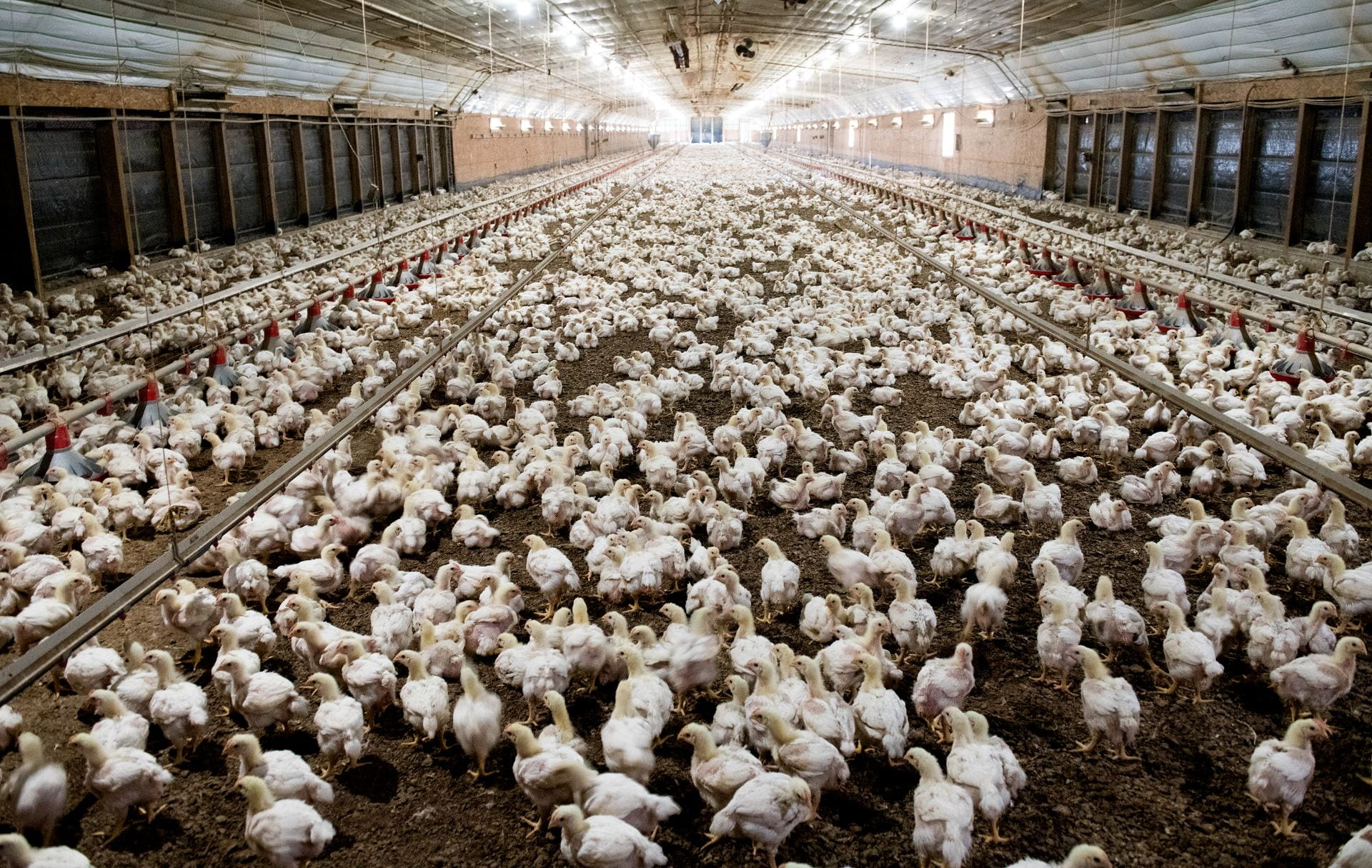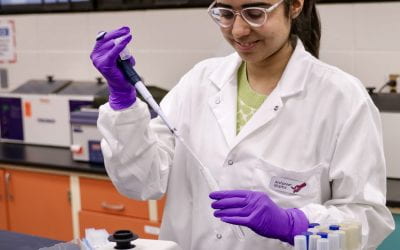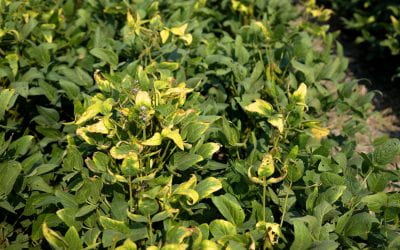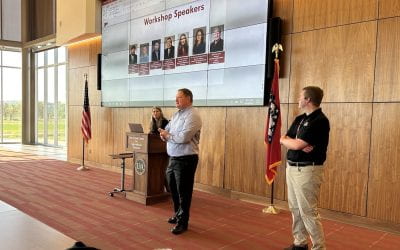YEAREND: Avian Influenza, Inflation Drive Up Poultry Prices; Faculty Additions Allow for More Specialized Research
Avian influenza, inflation caused price increases for poultry in 2022
By Jessica Wesson – Dec. 9, 2022

MEDIA CONTACT
Jessica Wesson
U of A System Division of Agriculture
Center of Excellence for Poultry Science
(479) 575-3327 | jlwesson@uark.edu
FAYETTEVILLE Ark. — The worst outbreak of highly pathogenic avian influenza in the United States disrupted production and led to increased poultry prices in 2022.
While the disease ravaged other states and Canadian provinces starting in spring, Arkansas dodged a bullet. However, the state’s luck ran out in October, with detection of its first 2022 case in Madison County. As of Dec. 7, three flocks were found to have the highly pathogenic strain of avian influenza, or HPAI.
The disease has been found in commercial and backyard flocks in 46 states and in wild birds in 47 states, according to the U.S. Department of Agriculture’s Animal and Plant Health Inspection Service. As of Dec. 7, 52.87 million birds have been affected, making this the most significant outbreak in U.S. history in terms of number of birds affected.
“Arguably, it wasn’t the best year for poultry production in general in the U.S.,” said Jada Thompson, assistant professor of agricultural economics and agribusiness for the Arkansas Agricultural Experiment Station, the research arm of the University of Arkansas System Division of Agriculture.
Thompson said Avian influenza caused serious logistical and marketing challenges for Arkansas producers.
“Farms that were in control areas had limited movements on and off farm, which leads to disruptions in normal business, causes stress and may lead to financial losses related to productivity or timing of processing,” Thompson said.
Thompson said the increased demand for replacement birds resulting from HPAI also contributed to supply chain challenges.
“HPAI was a lot more concentrated in turkey layer farms, because they are more susceptible to it than broilers,” she said. HPAI spreads more easily in turkeys and older birds like turkeys and layers who spend more time on the farm than broilers.
While HPAI was a challenge for both broiler and turkey producers alike, there was an increase in hatchings, she said.
“We did see an increase in hatching for broilers and a slight increase for turkeys,” Thompson said. “Producers started putting eggs in incubators to try to adjust for HPAI.”
2022 vs 2015
This industry’s response in 2022 differed from 2015, which had been the worst avian influenza year until 2022.
“When we first had HPAI in 2015, we were a little behind trying to figure out what was happening,” Thompson said. “This year had a lot of proactive measures that were taken to try to address supply shortages and to mitigate them as much as possible.”
Other challenges, along with HPAI, caused the price of poultry products to increase for consumers.
“We also saw a hike with inflation, which added to the supply chain disruptions,” Thompson said. “Fertilizer has gotten expensive, which makes producing corn more expensive. That makes feeding birds more expensive.”
Broiler prices have gone up 47 percent over the last year, according to Thompson. Turkey prices went up approximately 27 percent in 2022.
As HPAI lingers in late 2022, Thompson said that surveillance and monitoring for HPAI will likely continue into 2023.
“I think there will likely be some adjustment in the number of birds to try to offset the potential losses in 2023,” she said. “There are still a lot of unknowns which both help or hurt the poultry markets.
“I would like to be hopeful that the industry’s preemptive measures will help reduce the spread of HPAI and can adjust to the market conditions quickly to maintain their business continuity for producers and help ease some of the pressures on consumers,” Thompson said.
Protecting flocks
The Division of Agriculture’s Cooperative Extension Service performed outreach with commercial and backyard poultry growers to strengthen biosecurity in an effort to protect flocks. The disease surveillance effort got a boost in November when the Division of Agriculture’s Tollett Veterinary Diagnostic Lab was added to the National Animal Health Laboratory Network, or NAHLN, as a branch to the Arkansas Department of Agriculture’s Veterinary Diagnostic Lab.
Bolstering research
The Division of Agriculture conducts research and outreach to aid the poultry industry and the Bumpers College of Agricultural, Food and Life Sciences produces graduates prepared to enter the industry.
There were several new additions to the poultry science department and Center of Excellence for Poultry Science in 2022. Shawna Weimer was hired in January of this year to serve as the director for the Center for Food Animal Wellbeing, part of the Division of Agriculture.
In her role, Weimer is responsible for applying research to educate the public about animal welfare. She hosted the first Center for Food Animal Wellbeing symposium since 2017, and it focused on poultry welfare challenges.
“In one way or another all presenters spoke to the need for advanced poultry welfare research, the importance of team-oriented approaches and how humans are the most influential piece of the puzzle to improve the lives of poultry,” Weimer said.
Another addition to the Center of Excellence for Poultry Science is focusing her research on avian intestinal health. Danielle Graham, assistant professor, joined the center in July.
Graham said her long-term research goal is to utilize the existing knowledge base on parasitic diseases to investigate commercially applicable tools to enhance immunological protection in poultry.
Tomi Obe, assistant professor, joined the center in September to research foodborne pathogen control. She plans to improve control methods to benefit the poultry industry.
“Our goal is to use the information from our research to develop techniques to quickly identify virulent foodborne pathogens and establish targeted control strategies,” Obe said.
Obe also has a research appointment with the department of food science, making her the second faculty member having appointments in both poultry science and food science. Kristen Gibson, professor of food safety and microbiology with the food science department, was named director of the Center for Food Safety this year. In this role, Gibson has a partial appointment with the Center of Excellence for Poultry Science.
Smart farming research facility
The Poultry Science Smart Farming Research Facility, under construction at the Milo J. Shult Agricultural Research and Extension Center in Fayetteville, is expected to be completed in 2023.
“The facility will be equipped with the most technologically advanced, commercially relevant environmental control and rearing equipment available in the commercial industry today,” said David Caldwell, director of the Center of Excellence for Poultry Science and head of the department of poultry science.
The facility will also be used to teach students about poultry production.
To learn more about the Division of Agriculture research, visit the Arkansas Agricultural Experiment Station website: https://aaes.uada.edu. Follow us on Twitter at @ArkAgResearch and Instagram at @ArkAgResearch.
To learn about Extension Programs in Arkansas, contact your local Cooperative Extension Service agent or visit https://uaex.uada.edu/. Follow us on Twitter at @AR_Extension.
To learn more about the Division of Agriculture, visit https://uada.edu/. Follow us on Twitter at @AgInArk.
About the Division of Agriculture
The University of Arkansas System Division of Agriculture’s mission is to strengthen agriculture, communities, and families by connecting trusted research to the adoption of best practices. Through the Agricultural Experiment Station and the Cooperative Extension Service, the Division of Agriculture conducts research and extension work within the nation’s historic land grant education system.
The Division of Agriculture is one of 20 entities within the University of Arkansas System. It has offices in all 75 counties in Arkansas and faculty on five system campuses.
The University of Arkansas System Division of Agriculture offers all its Extension and Research programs and services without regard to race, color, sex, gender identity, sexual orientation, national origin, religion, age, disability, marital or veteran status, genetic information, or any other legally protected status, and is an Affirmative Action/Equal Opportunity Employer.
MEDIA CONTACT
Jessica Wesson
U of A System Division of Agriculture
Center of Excellence for Poultry Science
(479) 575-3327 | jlwesson@uark.edu
More Recent News
Food Scientists are Finding Ways to Preserve Food Quality and Ensure Food Safety
Food scientists develop framework to improve food quality and still kill pathogens By John Lovett – Apr. 12, 2024 QUALITY CONTROL — Arshpreet Khattra was the lead author of a study that developed a framework for food...
USDA-Grant Supported FRST Project Releases New Fertilizer Prediction Tool
Fertilizer recommendation tool for farmers could save money and reduce nutrient loss By John Lovett – Apr. 8, 2024 DECISION AID — Farmers have a new fertilizer decision aid available called FRST (Fertilizer...
Nathan McKinney Retires as Assistant Director of Experiment Station
By John Lovett – Mar. 7, 2024 RETIRED — Nathan McKinney retired from the Arkansas Agricultural Experiment Station at the end of March 2024.Nathan McKinney is known across the state of Arkansas as someone who has been...
Food Scientists are Finding Ways to Preserve Food Quality and Ensure Food Safety
Food scientists develop framework to improve food quality and still kill pathogens By John Lovett – Apr. 12, 2024 QUALITY CONTROL — Arshpreet Khattra was the lead author of a study that developed a framework for food...
USDA-Grant Supported FRST Project Releases New Fertilizer Prediction Tool
Fertilizer recommendation tool for farmers could save money and reduce nutrient loss By John Lovett – Apr. 8, 2024 DECISION AID — Farmers have a new fertilizer decision aid available called FRST (Fertilizer...
Nathan McKinney Retires as Assistant Director of Experiment Station
By John Lovett – Mar. 7, 2024 RETIRED — Nathan McKinney retired from the Arkansas Agricultural Experiment Station at the end of March 2024.Nathan McKinney is known across the state of Arkansas as someone who has been...
Value-Added Products Focus of ‘Plan. Produce. Profit!’ Workshop May 6
Value-added products provide options to cut down on food waste By John Lovett – Apr. 3, 2024 VALUE-ADDED — Rusty Rumley, senior staff attorney with the National Agricultural Law Center, will speak on liability in...




